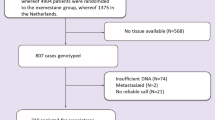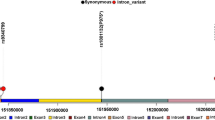Abstract
There are several risk factors related to Breast Cancer (BC) risks and response to chemotherapy with SERMs. Recently some single nucleotide polymorphisms (SNPs) on ESR1 gene have been associated to this disease. However, data are still inconclusive. The present study aimed to investigate the association of SNPs c454-397T>C (also called PvuII) and c454-351A>G (so called XbaI) to incidence of sporadic BC; ERα expression in BC; tamoxifen hormonetherapy (HT-TMX) responsiveness. To do so, a cohort of BC patients was analyzed through retrospective data collection, immunohistochemistry to ERα protein, and genotyping for PvuII and XbaI SNPs by PCR–RFLP, confirmed by sequencing. Significant difference in PvuII alleles frequencies were found BC patients when compared to control samples. Patients with P allele have a 5.14-fold increased BC risk. We found higher P and X alleles frequencies in ERα positive BC and the pp and xx genotypes were observed exclusively in patients with HT-TMX-responsive BC. Taken together, data indicates that P allele as a novel sporadic BC biomarker whereas p and x alleles enhanced chemotherapy responsiveness.

Similar content being viewed by others
References
Jemal A, Siegel R, Ward E et al (2009) Cancer statistics. CA Cancer J Clin 59:225–249
Smith RA, Cokkinides V, Brooks D, Saslow D, Brawley OW (2010) Cancer Screening in the United States, 2010: a Review of Current American Cancer Society Guidelines and Issues in Cancer Screening. CA Cancer J Clin 60:99–119
Cancer Reference Information. American Cancer Society. Disponível em: www.cancer.org/docroot/CRI/CRI_0.asp. Acesso em: 01 dez. 2010
Instituto Nacional do Câncer. Disponível em: http://www.inca.gov.br/estimativa/2010. Acesso em: 12 dez. 2010
Risbridger GP, Davis ID, Birrell SN, Tilley WD (2010) Breast and prostate cancer: more similar than different. Nat Rev Cancer 10:205–212
Greene GL et al (1986) Sequence and expression of human estrogen receptor complementary DNA. Science 231:1150–1154
Krust A et al (1986) The chicken oestrogen receptor sequence: homology with v-erb-A and the human oestrogen and glucocorticoid receptors. EMBO J 5:891–897
Kuiper G et al (1997) Comparison of the ligand binding specificity and transcript tissue distribuition of estrogen receptor α and β. Endocrinology 138:863–870
Perissi V, Rosenfeld MG (2005) Controlling nuclear receptors: the circular logic of cofactor cycles. Nat Rev Mol Cell Biol 6:542–554
Fu XD, Simoncini T (2008) Extra-nuclear signaling of estrogen receptors. Ubmd life 60:502–510
Madeira KP, Daltoé RD, Sirtoli GM, Rezende LC, Carvalho AA (2012) Guimarães Idos S, Silva IV, Rangel LB. (2012) Comparison of immunohistochemical analysis with estrogen receptor SP1 and 1D5 monoclonal antibodies in breast cancer. Pathol Res Pract 208(11):657–661
Schiff R, Osborne CK (2005) New insight into estrogen receptor α function and its application for endocrine therapy resistance in breast cancer. Breast Cancer Res 7:205–211
Wang PH (2005) Role of sex hormone receptors in ovulation. Taiwan J Obstet Gynecol 44:16–25
Albanito L et al (2008) G-protein-coupled receptor 30 and estrogen receptor-alpha are involved in the proliferative effects induced by atrazine in ovarian cancer cells. Environ Health Perspect 116:1648–1655
Warner M, Gustafsson J (2010) The role of estrogen receptor β (ER β) in malignant diseases-A new potential target for antiproliferative drugs in prevention and treatment of cancer. Biochem Biophys Res Commun 396:63–66
Mcpherson SJ et al (2010) Estrogen receptor-beta activated apoptosis in benign hyperplasia and cancer of the prostate is androgen-independent and TNF-alpha mediated. Proc Natl Acad Sci 1073:3123–3128
Birrell SN et al (1995) Androgens induce divergent proliferative responses in human breast cancer cell lines. J Steroid Biochem Mol Biol 52:459–467
Labrie F et al (2003) Endocrine and intracrine sources of androgens in women: inhibition of breast cancer and other roles of androgens and their precursor dehydroepiandrosterone. Endocr Rev 24:152–182
Birrell SN et al (2007) Disruption of androgen receptor signaling by synthetic progestins may increase risk of developing breast cancer. FASEB J 21:2285–2293
Peters AA et al (2009) Androgen receptor inhibits estrogen receptor-α activity and is prognostic in breast cancer. Cancer Res 69:6131–6140
Ellem SJ, Risbridger GP (2009) The dual, opposing roles of estrogen in the prostate. Ann NY Acad Sci 1155:174–186
Russo J et al (2003) Estrogen and its metabolites are carcinogenic agents in human breast epithelial cells. J Steroid Biochem Mol Biol 87:1–25
Jensen EV, Jordan VC (2003) The estrogen receptor: a model for molecular medicine. Clin Cancer Res 9:1980–1989
Maehle BO et al (2009) Estrogen receptor β an independent prognostic marker in estrogen receptor a and progesterone receptor-positive breast cancer? APMIS 117:644–650
Riggs BL, Hartmann LC (2003) Selective estrogen-receptor modulators: mechanisms of action and application to clinical practice. N Engl J Med 348:618–629
Hopp TA et al (2004) Low levels of estrogen receptor beta protein predict resistance to tamoxifen therapy in breast cancer. Clin Cancer Res 10:7490–7499
Hartman J, Strom A (2009) Estrogen receptor beta in breast cancer-diagnostic and therapeutic implications. Steroids 74:635–641
Kahlert S et al (2000) Estrogen receptor alpha rapidly activates the IGF-1 receptor pathway. J Biol Chem 275:18447–18453
Miki Y et al (1994) A strong candidate for the breast and ovarian cancer susceptibility gene BRCA1. Science 266:66–71
Wooster R et al (1995) Identification of the breast cancer susceptibility gene BRCA2. Nature 378:789–792
Edlich RF, Winters KL, Lin KY (2005) Breast cancer and ovarian cancer genetics. J Long Term Eff Med Implants 15:533–545
Chen YC, Hunter DJ (2005) Molecular epidemiology of cancer. CA Cancer J Clin 55:45–54
Tanaka Y et al (2003) Polymorphisms of estrogen receptor alpha in prostate cancer. Mol Carcinog 37:2002–2005
Hernández J (2006) Association between an estrogen receptor alpha gene polymorphism and the risk of prostate cancer in black men. J Urol 175:523–527
Weiderpass E et al (2000) Estrogen receptor α polymorphisms and endometrial cancer risk. Carcinogenesis 21:623–627
Bergink AP et al (2003) Estrogen receptor α gene haplotype is associated with radiographic osteoarthritis of the knee in elderly men and women. Arthritis Rheumatism 48:1913–1922
Wang J et al (2007) Estrogen receptor alpha haplotypes and breast cancer risk in older Caucasian women. Breast Cancer Res Treat 106:273–280
Lian K et al (2007) Estrogen receptor alpha genotype is associated with a reduced prevalence of radiographic hip osteoarthritis in elderly Caucasian women. Osteoarthritis Cartilage 15:972–978
Gennari D et al (2005) Estrogen Receptor Gene Polymorphisms and the Genetics of Osteoporosis: a HuGE Review. Am J Epidemiol 161:307–320
Goelz SE, Hamilton SR, Volgerstin B (1985) Purification of DNA from formaldehyde fixed and paraffin embedded human tissue. Biochem Biophys Res Commun 130:118–126
Stuart-Harris R, Davis A (2010) Optimal adjuvant endocrine therapy for early breast cancer. Womens Health (Lond Engl) 6:383–398
Osborne CK, Fuqua SAW (2004) Mechanisms of Tamoxifen resistance. Endocr-Relat Cancer 11:643–658
Fasching PA et al (2009) Role of genetic polymorphisms and ovarian cancer susceptibility. Mol Oncol 3:171–181
Kenemans P, Verstraeten RA, Verheijen RH (2008) Oncogenic pathways in hereditary and sporadic breast cancer. Maturitas 61:141–150
Araujo KL et al (2009) The role of Single Nucleotide Polymorphisms (SNPs) Pvu II E Xba I and Short Tandem Repeats (STRs) (TA)n and (GT)n of estrogen receptor alpha (ESR1) on breast cancer (BRCA) susceptility. Revista Brasileira de Cancerologia 55:185–192
Araujo KL et al (2011) Prevalence of estrogen receptor alpha PvuII and XbaI polymorphisms in a population of Brazilian women. Braz Arch Biol Technol 54:1151–1157
Gold B et al (2004) Estrogen receptor genotypes and associated with breast cancer risk. Cancer Res 64:8891–8900
Gonzáles-zuoleta AM et al (2008) Estrogen receptor α polymorphisms and postmenopausal breast cancer risk. Breast Cancer Res Treat 107:415–419
Cai Q (2003) Genetic polymorphism in the estrogen receptor α gene and risk of breast cancer: results from the Shangai breast cancer study. Cancer Epidemiol Biomarkers Prev 12:853–859
Andersen IT et al (1994) Oestrogen receptor (ESR) polymorphisms and breast cancer susceptibility. Hum Genet 94:665–670
Shin A et al (2003) Estrogen receptor alpha gene polymorphisms and breast cancer risk. Breast Cancer Res Treat 80:127–131
Hill SM et al (1989) Estrogen receptor expression in human breast cancer associated with a estrogen receptor gene restriction fragment length polymorphism. Cancer Res 49:145–148
Yaich L, Dupont WD, Cavener DR, Parl F (1992) Analysis of the restriction fragment length polymorphism and exon structure of the estrogen receptor gene in breast cancer and peripheral blood. Cancer Res 52:77–83
Herrington DM et al (2002) Common estrogen receptor polymorphism augments effects of hormone replacement therapy on E-selectin but not C-reactive protein. Circulation 105:1879–1882
Jakimiuk AJ et al (2007) Prevalence of estrogen receptor α PvuII and XbaI polymorphism in population of Polish postmenopausal women. Folia Histochem Cytobiol 45:331–338
Prentice RL et al (2009) Variation in the FGFR2 gene and the effects of postmenopausal hormone therapy on invasive breast cancer. Cancer Epidemiol Biomarkers Prev 18:3079–3085
Kobayashi S et al (1996) Association of bone mineral density with polymorphism of the estrogen receptor gene. J Bone Miner Res 11:306–311
Blaszyk H et al (1996) A polymorphism but no mutations in the GADD45 gene in breast cancers. Hum Genet 97:543–547
Goessl C et al (1997) An intronic germline transition in the HNPCC gene hMSH2 is associated with sporadic colorectal cancer. Eur J Cancer 33:1869–1874
Maruyama H et al (2000) Lack of an association of estrogen receptor α gene polymorphisms and transcriptional activity with alzheimer disease. Arch Neurol 57:24–236
Silva IV, Rezende LCD, Lanes SP et al (2010) Evaluation of PvuII and XbaI polymorphisms in the estrogen receptor alpha gene (ESR1) in relation to menstrual cycle timing and reproductive parameters in post-menopausal women. Maturitas 53:213–220
Acknowledgments
This paper was accomplished with grants from CNPq, CAPES, FAPES, and FACITEC from IVS to LBAR.
Declaration of Interest
The authors report no conflicts of interest.
Author information
Authors and Affiliations
Corresponding author
Rights and permissions
About this article
Cite this article
Madeira, K.P., Daltoé, R.D., Sirtoli, G.M. et al. Estrogen receptor alpha (ERS1) SNPs c454-397T>C (PvuII) and c454-351A>G (XbaI) are risk biomarkers for breast cancer development. Mol Biol Rep 41, 5459–5466 (2014). https://doi.org/10.1007/s11033-014-3419-8
Received:
Accepted:
Published:
Issue Date:
DOI: https://doi.org/10.1007/s11033-014-3419-8




